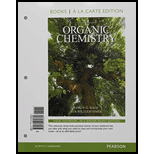
Concept explainers
(a)
Interpretation:
The conversion of
Concept introduction:
Thionyl chloride in dioxane
(b)
Interpretation:
The conversion of
Concept introduction:
Phosphorous bromide
(c)
Interpretation:
The conversion of
Concept introduction:
The conversion of
Want to see the full answer?
Check out a sample textbook solution
Chapter 11 Solutions
Organic Chemistry, Books a la Carte Edition (9th Edition)
- What is the name of the following compound? SiMe3arrow_forwardK Draw the starting structure that would lead to the major product shown under the provided conditions. Drawing 1. NaNH2 2. PhCH2Br 4 57°F Sunny Q Searcharrow_forward7 Draw the starting alkyl bromide that would produce this alkyne under these conditions. F Drawing 1. NaNH2, A 2. H3O+ £ 4 Temps to rise Tomorrow Q Search H2arrow_forward
 Organic ChemistryChemistryISBN:9781305580350Author:William H. Brown, Brent L. Iverson, Eric Anslyn, Christopher S. FootePublisher:Cengage Learning
Organic ChemistryChemistryISBN:9781305580350Author:William H. Brown, Brent L. Iverson, Eric Anslyn, Christopher S. FootePublisher:Cengage Learning
